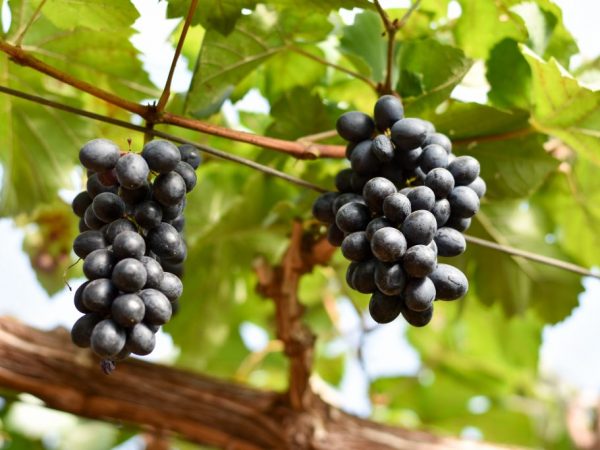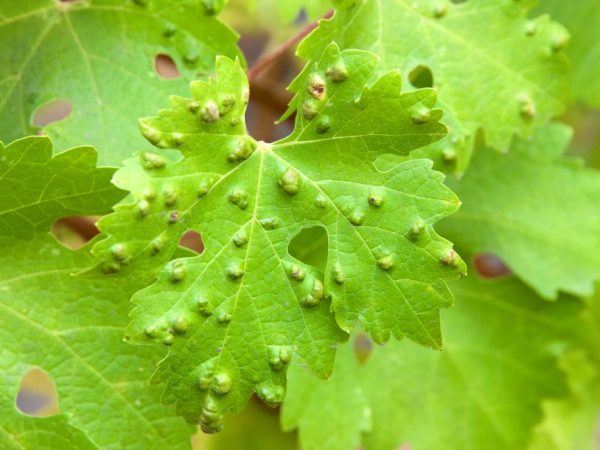Gala grapes
Gala grape is a hybrid variety bred by crossing the Zaporozhye gift and Kodryanka. The variety prefers the temperate climate of the middle continental belt.

Gala grapes
Characteristics of the variety
Gala grapes are fast-ripening table grapes. The period during which the berries reach maturity from the beginning of the growing season is 120-130 days. It has a stable and high yield. Frost resistance and disease immunity are average. The bushes feel fine at temperatures down to -18 ℃. According to the description of the variety, its disadvantage is whimsical to growing conditions and care.
Description of the bush
The bush has a similar description with other early-growing varieties. The vine reaches 2 m in height. The leaves are large, deep green.
Gala grape flowers are hermaphrodites. The workload of the branches is average.
Description of fruits
According to the description, the fruits of the Gala grapes are oval and egg-shaped. The average weight of 1 berry is 8.5 g, and the weight of the vine reaches 700 g.
The taste is the same as for other table varieties. The berries are sweet with a slight sourness in the aftertaste. The pulp is firm and juicy. Fruits grow densely in large conical clusters.
Growing varieties
Growing conditions
Gala grapes are grown by cuttings. It is required to choose a quality seedling. It should be free of physical damage, stains and signs of infection.
The variety has good adaptability to new conditions, but it is better to plant several cuttings in 1 hole so that they will definitely start.
It is better to grow Gala in warm climates. The site must be well lit and protected from drafts. It should be planted in loose soils so that the root system has enough moisture and oxygen.
Landing in the soil
It is better to plant Gala grapes in the ground in early spring, when it is already warm outside. Before planting, the seedling is pruned. The roots and shoots are shortened, leaving only the strongest segments.
Disembarkation sequence:
- dig a hole 60-80 cm deep;
- fill its bottom with a mixture of soil and fertilizers;
- plant a seedling in the hole;
- cover with a layer of earth on top, without tamping.
The distance between the bushes should be 2-2.5 m. Also, grooves are made around the bush for mulching with leaves or straw, which allows you to retain moisture in cold seasons.
Plant care

It is necessary to monitor the number of bunches
Gala grapes require regular maintenance. During the fruiting period, make sure that the bunches do not overload or break the branches. Also carry out the autumn pruning of vines and buds.
For the winter, the grapes are covered with a layer of soil, and in the spring the shelter is removed when a warm temperature at night is reached. In summer, care consists in tying up branches and examining the bush for diseases.
Fertilizer
The following minerals are used as fertilizer:
- nitrogen (ammonium nitrate and urea);
- phosphorus (double granular superphosphate);
- potassium (potassium salt, potassium chloride, Ecoplant).
There are complexes that contain all the necessary substances. The first fertilizers are applied immediately after removing the winter shelter. A mixture of 35 g of superphosphate, 25 g of potassium and 40 g of nitrogen per plant is added to the soil.
The second top dressing is applied 14 days before the beginning of the flowering period. An aqueous solution of chicken manure is added to the soil in a ratio of 1: 6. You can also add potash fertilizer and superphosphate to the mixture.
Fertilizers are applied at the beginning of the ripening period of berries. To do this, use 50 g of phosphorus and 25 and superphosphate per 1 bush.
Watering
- the first watering is carried out immediately after planting or garter;
- the second - 7 days after pruning;
- the third is carried out to accelerate growth with a shoot height of 35 cm;
- the fourth introduction of moisture is carried out a week before the beginning of flowering;
- fifth - when ripe berries appear;
- the sixth watering is carried out before harvesting.
Watering is also carried out at the end of autumn to obtain moisture for the plant for the winter. Superphosphate and ash are added to the water. Young plants are watered using pipes in the ground. They also dig holes 45 cm deep near the bush and bring moisture into them.
Diseases and pests

Insects can attack grapes
The variety has good immunity to fungal diseases, but is not completely protected from them. Gala grapes are also affected by harmful insects.
Diseases of the variety:
- Anthracnose. A fungal disease that affects fruits, leaves and shoots. It causes tissue death and the appearance of spots on the berries.
- Oidium. The disease is a consequence of the development of a fungus that causes powdery mildew. Causes the death of inflorescences and wilting of fruits. Develops in high humidity.
- Mildew. A fungal disease that affects the green segments of the bush. Causes loss of foliage and death of segments. Symptoms are white patches all over the bush.
- Gray rot affects the green parts of the bush and grafting sites. Causes the appearance of bloom on the bunches and the death of berries.
- Black spotting causes discoloration of the surface of the branches and the appearance of rot. The leaves turn yellow and fall off.
Gala grape pests:
- grape aphid;
- caterpillars of leaf rollers;
- cicadas;
- zitka;
- mite;
- pillow case.
Fight disease
To combat fungal diseases, the following means are used:
- Bordeaux mixture;
- Horus;
- Acrobat;
- Thanos;
- Ridomil;
- Anthracol;
- Topaz;
- Strobe;
- Tiovit.
Mulching and the introduction of phosphorus fertilizers also help against fungal infections. Folk remedies from onion peels, dill decoction and wood ash powder are effective in the fight.
Pest control
The following remedies help against pests of grapes:
- Zolon;
- Confidor;
- Actellik;
- Neoron;
- Omite;
- Furafon.
Treatment of bushes with Nitrafen helps from caterpillars. To do this, prepare a mixture of 5 liters of water and 120 g of the chemical. To get rid of butterflies, Corbaphos and Benzophosphate are used.
Prophylaxis
To prevent the disease of Gala grapes, all agronomic requirements must be met. Prevention is the timely introduction of moisture and fertilizers.
It is also required to regularly inspect the bushes for the presence of fungus, rot and insects. When an infection appears, the affected segments of the bush are removed, and the wounds are treated with a growth stimulant.
Conclusion
Gala grapes bear poor fruit in cold climates, but yields well in the middle lane. Its fruits are suitable for consumption in raw and processed form, and also tolerate transportation well.


